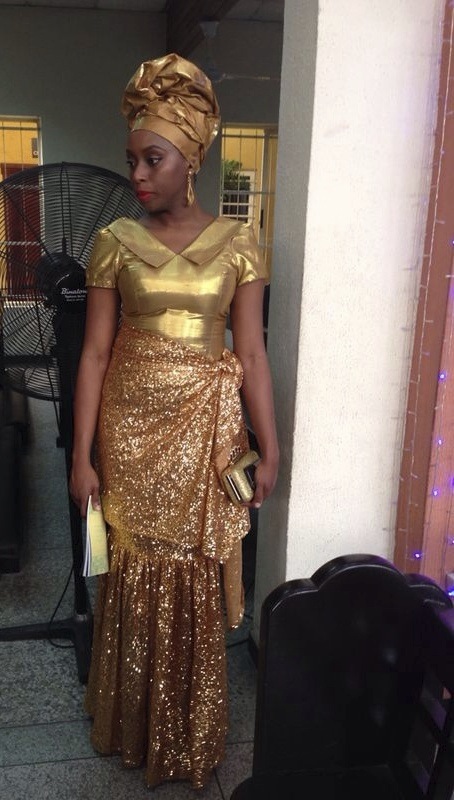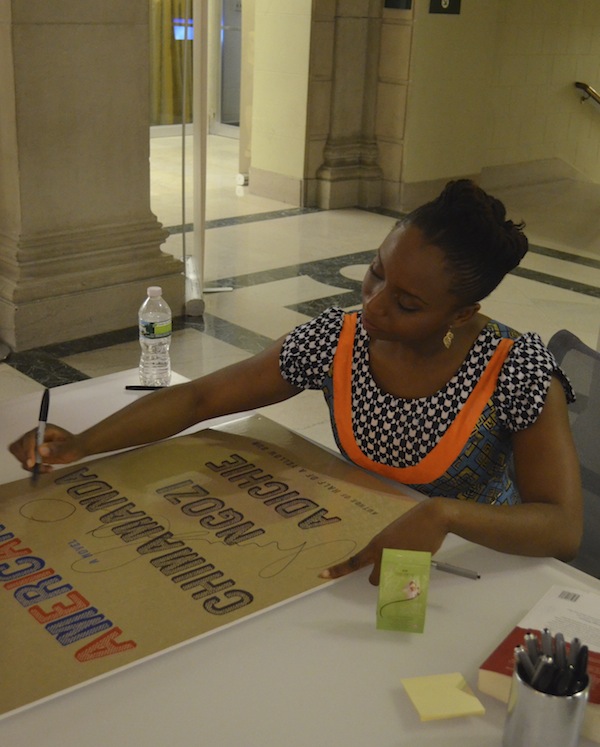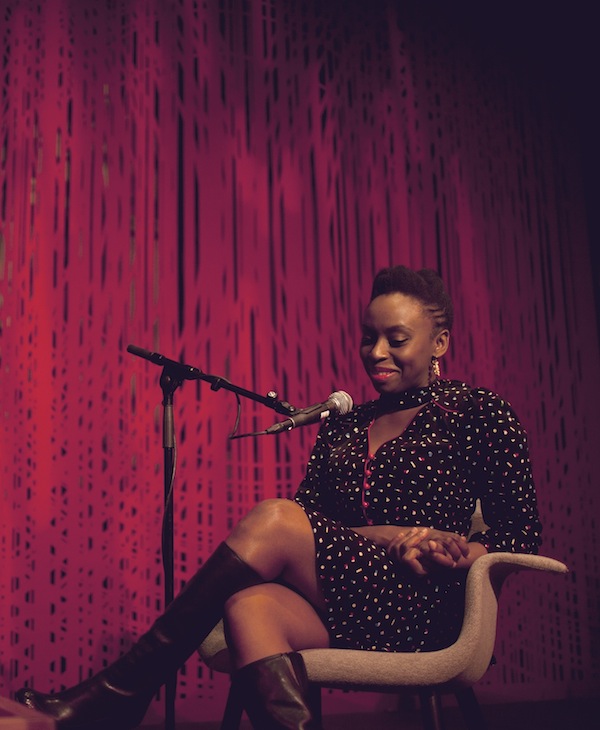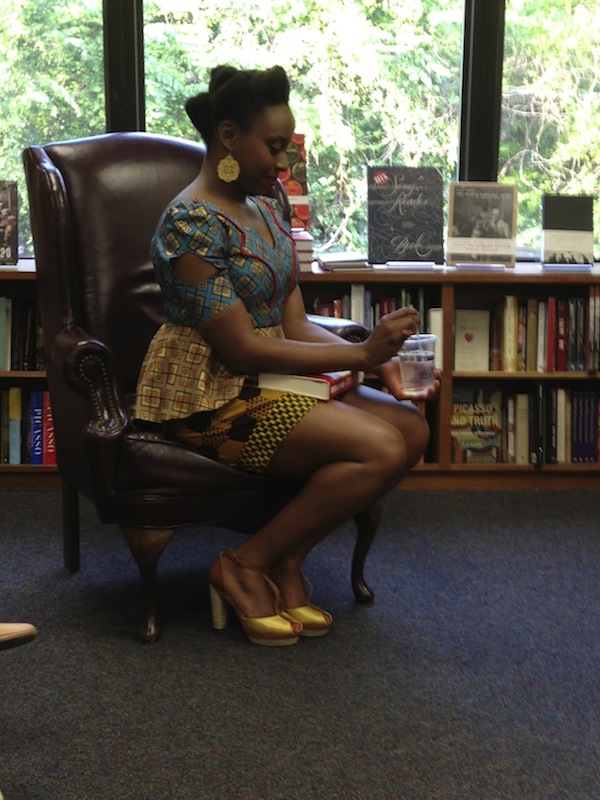
This is the title of a great article written by Chimamanda Ngozi Adichie in Elle.com:
As a child, I loved watching my mother get dressed for Mass. She folded and twisted and pinned her
ichafu
until it sat on her head like a large flower. She wrapped her
george—heavy beaded cloth, alive with embroidery, always in bright
shades of red or purple or pink—around her waist in two layers. The
first, the longer piece, hit her ankles, and the second formed an
elegant tier just below her knees. Her sequined blouse caught the light
and glittered. Her shoes and handbag always matched. Her lips shone with
gloss. As she moved, so did the heady scent of Dior Poison. I loved,
too, the way she dressed me in pretty little-girl clothes, lace-edged
socks pulled up to my calves, my hair arranged in two puffy bunny-tails.
My favorite memory is of a sunny Sunday morning, standing in front of
her dressing table, my mother clasping her necklace around my neck, a
delicate gold wisp with a fish-shape pendant, the mouth of the fish open
as though in delighted surprise.
For her work as a university administrator, my mother also wore color: skirt suits, feminine swingy
dresses
belted at the waist, medium-high heels. She was stylish, but she was
not unusual. Other middle-class Igbo women also invested in
gold jewelry,
in good shoes, in appearance. They searched for the best tailors to
make clothes for them and their children. If they were lucky enough to
travel abroad, they shopped mostly for clothes and shoes. They spoke of
grooming almost in moral terms. The rare woman who did not appear well
dressed and well lotioned was frowned upon, as though her appearance
were a character failing. “She doesn’t look like a person,” my mother
would say.
As a teenager, I searched her trunks for crochet tops from the 1970s.
I took a pair of her old jeans to a seamstress who turned them into a
miniskirt. I once wore my brother’s tie, knotted like a man’s, to a
party. For my 17th birthday, I designed a halter maxidress, low in the
back, the collar lined with plastic pearls. My tailor, a gentle man
sitting in his market stall, looked baffled while I explained it to him.
My mother did not always approve of these clothing choices, but what
mattered to her was that I made an effort. Ours was a relatively
privileged life, but to pay attention to appearance—and to look as
though one did—was a trait that cut across class in Nigeria.
When I left home to attend university in America, the insistent
casualness of dress alarmed me. I was used to a casualness with
care—T-shirts ironed crisp, jeans altered for the best fit—but it seemed
that these students had rolled out of bed in their pajamas and come
straight to class. Summer shorts were so short they seemed like
underwear, and how, I wondered, could people wear rubber flip-flops to
school?
Still, I realized quickly that some outfits I might have casually
worn on a Nigerian university campus would simply be impossible now. I
made slight amendments to accommodate my new American life. A lover of
dresses
and skirts, I began to wear more jeans. I walked more often in America,
so I wore fewer high heels, but always made sure my flats were
feminine. I refused to wear sneakers outside a gym. Once, an American
friend told me, “You’re overdressed.” In my short-sleeve top, cotton
trousers, and high wedge sandals, I did see her point, especially for an
undergraduate class. But I was not uncomfortable. I felt like myself.
My writing life changed that. Short stories I had been working on for
years were finally receiving nice, handwritten rejection notes. This
was progress of sorts. Once, at a workshop, I sat with other unpublished
writers, silently nursing our hopes and watching the faculty—published
writers who seemed to float in their accomplishment. A fellow aspiring
writer said of one faculty member, “Look at that dress and makeup! You
can’t take her seriously.” I thought the woman looked attractive, and I
admired the grace with which she walked in her heels. But I found myself
quickly agreeing. Yes, indeed, one could not take this author of three
novels seriously, because she wore a pretty dress and two shades of eye
shadow.
The celebrated writer was featured in an online fashion website ''the fashion bomb daily'' as the fashion bombshell of the day and shared some of her different stylish looks(see below).
She writes,
“
It’s hard to talk about what ‘my style’ is.”
” You know those magazine features that ask you to choose if you’re
‘classic’ or ‘romantic’ or ‘preppy’ or whatever? I often find myself
choosing all, and sometimes none. My style is What Makes Me Happy.”
“I have clothes that other people tell me are lovely but I don’t love them.”
” And there are clothes I wear and love, about which my family and
friends will say things like, ‘you look like you’re wearing a man’s
shirt that isn’t your size.’ Or ‘is that really how that top is supposed
to look?’ Or ‘I don’t understand this dress.’”
And I actually see their point! But what matters in the end is what
makes me feel, when I look in the mirror, fully like myself.”















Her sense of style can be a bit odd and I like it
ReplyDeleteNgozi the leg crosser :) nice pixs
ReplyDeleteOmalicha nwa and my namesake
ReplyDeleteI love this article and her fashion sense
ReplyDeleteWhat I like about her style is that its unpredictable!
ReplyDeleteShe is quite stylish, for me fashion is what suits u and what u feel comfy in period.
ReplyDelete